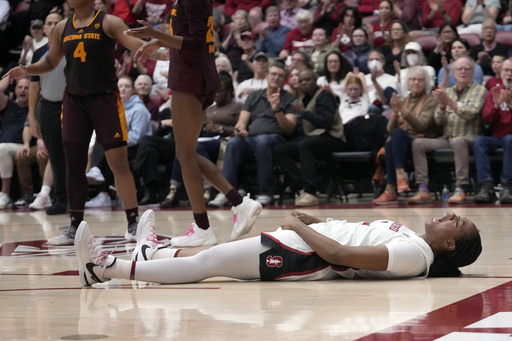Arizona guard Pelle Larsson takes a devilish pride in drawing charges, even if it leaves him battered, bruised and buried in ice bags after every game.
“It makes the offense look kind of stupid, to be honest,” Larsson said. “It’s even better than a steal or a block. It’s a turnover and a foul, so it’s the best defensive play you can make.”
Drawing an offensive foul is often a momentum changer, putting a charge in the charge-taking team, deflating the offending defenders.
It’s also been a massive point of consternation, a slippery slope on which no one’s exactly sure where the parameters for a block or a charge fall with the players who crash to the hardwood.
The NCAA took a stab at clarifying block-charge calls with a new set of guidelines for the 2023-24 season.
Unlike past attempts, this one seems to have hit the mark.
“I think it’s been good. I do,” Houston coach Kelvin Sampson said. “It’s one of those rules, I think it’s made it easier for the officials because now it’s clearly cut and dry.”
The NCAA Playing Rules and Oversight Panel laid out the new rules over the summer.
A defender now must be in position at the time the offensive player plants a foot to go airborne for a shot. If the defender arrives after the player has planted, officials have been instructed to call a block when there’s contact. Secondary defenders also have to be outside the restricted arc to draw a charge.
Previously, defenders only had to be in position to draw a charge before the offensive player went airborne.
As a result, all those instances of sliding in front of a driver, secondary offenders jumping in the way at the last second or undercutting a player already airborne are now automatic block calls.
“I can only tell you from what I have witnessed and what I have heard from officials and coaches,” NCAA coordinator of officiating Chris Rastatter said. “The number of block/charge plays at the basket is way down, which was the main intent of the rule change. I believe the impact of the rule change has been positive.”
The numbers back it up.
Scoring is up across college basketball — 73.89 points per game so far after finishing 71.76 last season.
Alabama (91.1) and Arizona (90.1) are the first teams to average more than 90 points per game since Gonzaga in 2020-21. The number of teams averaging at least 80 points per game has increased from 18 last year to 44 this season.
The NCAA doesn’t differentiate types of offensive fouls, but the eye test has been pretty clear so far.
“I think what you’re seeing is more scoring at the rim,” Arizona associate head coach Jack Murphy said. “Defenses have had to adjust. Way more vertical contests and less bang-bang plays at the rim that are 50/50 block/charge. I think it’s been good for the game.”
It definitely was an adjustment.
Early in the season, players who were used to sliding in front of driving opponents to take a charge often found themselves being hit with blocking calls. Once they got the hang of it, the collisions around the rim diminished and the game became more free flowing.
And, unlike previous attempts to emphasize block/charge calls, officials have — for the most part — stuck with the way they’re calling games, even into the more-physical conference seasons in January and February.
“It’s similar to league basketball or European basketball where you need to be there way earlier,” Larsson said. “You can’t really flop as much and just get the call. Used to be, you could just fall and they would call a charge.”
Not anymore — and the game seems to be better for it.
___
Get poll alerts and updates on AP Top 25 basketball throughout the season. Sign up here. AP college basketball: https://apnews.com/hub/ap-top-25-college-basketball-poll and https://apnews.com/hub/college-basketball



